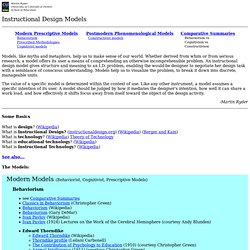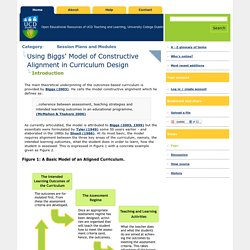

Net.educause.edu/ir/library/pdf/ELI7066.pdf. "An Online Course Design Model Utilizing Brain-Based Learning Theory" by Abreena Walker Tompkins, et al. Instructional Design Models. Instructional Design Models Models, like myths and metaphors, help us to make sense of our world.

Whether derived from whim or from serious research, a model offers its user a means of comprehending an otherwise incomprehensible problem. An instructional design model gives structure and meaning to an I.D. problem, enabling the would-be designer to negotiate her design task with a semblance of conscious understanding. Models help us to visualize the problem, to break it down into discrete, manageable units. The value of a specific model is determined within the context of use. -Martin Ryder Some Basics What is design? See also... The Models: Comparitive Summaries. Intro to Online Course Design.
"Design is not just what it looks like and feels like.

Design is how it works. " — Steve Jobs As an online instructor, you may find yourself involved in numerous roles related to online course design. Whether you are responsible for the conversion or adaptation of a traditional course for online delivery, assigned to teach courses that were previously designed and developed by others, or relied on for content expertise as a member of a design and development team, your understanding of the online course design process is crucial to the development of an effective learning environment for future students. Online course design requires a wide range of skills and tools.
It is important to manage both the design, with a focus on learning objectives, and the technical aspects. Instructional Design & Technology Instructional Design and Technology is an area of study and practice that is constantly evolving. Models, Theories, and Frameworks Competencies Online Learning Quality Initiatives Analysis. Using Biggs' Model of Constructive Alignment in Curriculum Design/Introduction - UCD - CTAG. The main theoretical underpinning of the outcomes-based curriculum is provided by Biggs (2003).

He calls the model constructive alignment which he defines as: …coherence between assessment, teaching strategies and intended learning outcomes in an educational programme. (McMahon & Thakore 2006) As currently articulated, the model is attributed to Biggs (2003, 1999) but the essentials were formulated by Tyler (1949) some 50 years earlier - and elaborated in the 1980s by Shuell (1986). At its most basic, the model requires alignment between the three key areas of the curriculum, namely, the intended learning outcomes, what the student does in order to learn, how the student is assessed. Figure 1: A Basic Model of an Aligned Curriculum. Figure 2: An Example of Constructive Alignment in a Curriculum (Further examples are given in Appendix 1) Biggs actually suggests that teaching and learning activities are designed second and the assessment regime third (page 30). Blended Learning Toolkit. Tutorial overview. Understanding by Design.
Overview Understanding by Design, an excellent book by Grant Wiggins and Jay McTighe, offers a powerful framework for designing courses through what they call “Backward Design.”

It seems “backward” in that it starts from the opposite end of the planning process we typically go through to design courses—we usually start by thinking about how to teach our content. Backward Design, in contrast, leaves teaching activities until the end and starts with the desired results of that teaching. In other words, Wiggins and McTighe argue that you can’t start planning how you’re going to teach until you know exactly what you want your students to learn.
“Teaching is a means to an end. The Backward Design process proceeds in three phases, as follows: I. First, you establish your learning goals for the course. What should participants hear, read, view, explore or otherwise encounter? II. III. Resources Understanding by Design is available online and in the CFT library.